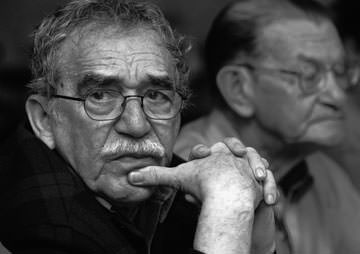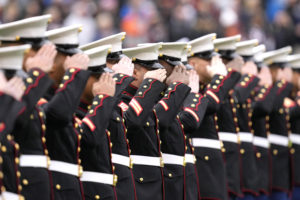Where Macondo Came Alive
Years before I met him, Gabriel Garcia Marquez changed my life. Colombian Nobel laureate Gabriel Garcia Marquez, left, is seen in Monterrey, Mexico, in 2003. Behind is Colombian journalist Jose Salgar. AP/Andres Reyes, FNPI
Colombian Nobel laureate Gabriel Garcia Marquez, left, is seen in Monterrey, Mexico, in 2003. Behind is Colombian journalist Jose Salgar. AP/Andres Reyes, FNPI
Years before I met him, Gabriel Garcia Marquez changed my life.
“One Hundred Years of Solitude” gave me a new way of looking at the world. The label “magical realism” does not begin to capture the poetry of Garcia Marquez’s imagination or the evocative power of his prose. Reading his masterpiece was like stepping through a portal into a Technicolor reality where the streets are paved with metaphor and the air is fragrant with dreams.
Garcia Marquez, who died Thursday at 87, was my introduction to modern Latin American literature. I wanted more.
When I got a Nieman fellowship at Harvard — a year off to study anything I wanted — the first thing I did was sign up for a literature course taught by the great Mexican novelist Carlos Fuentes. I hoped someday to read my favorite authors in their native tongue, so I took a Spanish-language course. The novels I was reading referred to unfamiliar events, so I enrolled in a Latin American history course.
Midway through the academic year, I learned that The Washington Post’s South America bureau was coming open. I had prepared myself for the job — accidentally — and so instead of returning to Washington in the summer of 1988, I moved with my family to Buenos Aires.
In four years of crisscrossing the continent, I felt as if Garcia Marquez were my constant companion. The name of the fictional town where “One Hundred Years of Solitude” is set — Macondo — became shorthand for the bizarre, magical-realist things that happened all the time in Latin America but seemingly nowhere else.
Here’s one example, not from the deepest Amazon or the highest Andes but from the heart of cosmopolitan Buenos Aires: Two women are walking side by side down the street. For no particular reason, they change places. High above, a dog falls from an apartment balcony and lands on one woman’s head, killing her. A pedestrian crossing the street sees the fatal accident, is understandably distracted, and gets run over by a bus. An elderly man who witnesses the entire sequence of events clutches his chest and falls dead of a heart attack.
Macondo.
I especially thought of Garcia Marquez during reporting trips to Colombia, where he was known by the nickname “Gabo.” I wanted to meet him but he was never around — he lived in Mexico City and visited his homeland infrequently. Unrelenting violence involving drug traffickers, leftist guerrillas, paramilitary groups and the Colombian armed forces meant that my forays into the countryside had to be brief. I felt I never had the chance to fully experience the source of Garcia Marquez’s inspiration.
I was settled back in Washington when, in 1995, I got a phone call from Maria Jimena Duzan, a friend in Colombia and a brave columnist for El Espectador — the newspaper where Garcia Marquez once worked. She said a group of American journalists was being invited to take a tour of the Colombian drug industry, and wondered if I wanted to come. I told her no thanks, I’d seen more than enough. She said she understood, but I might want to reconsider because “the tour guide is Gabo.”
So I flew down and spent three days hopscotching across Colombia with a handful of U.S. and Colombian journalists and Gabriel Garcia Marquez. We started in the coastal city of Cartagena and went to an Amazon basin town, the trafficking centers of Medellin and Cali, and finally Bogota. The great man was warm and funny, less the brooding novelist than the quick-witted journalist — curious, a bit cynical, easy to laugh.
He pitched a fit when he came to suspect that the trip, ostensibly sponsored by a civic-minded nonprofit, was actually a propaganda exercise by the Colombian government. He had agreed to come, he said, because he wanted Americans to understand what their insatiable demand for drugs was doing to his country.
One stop was Itagui prison near Medellin, where a cellblock had been modified to comfortably house the three Ochoa brothers — pioneering drug traffickers who surrendered in exchange for light sentences. This is from the story I wrote:
“In addition to offering conversation, the Ochoas offered lunch — ground beef, rice, beans, avocado and pork rinds. There, around two long tables in the exercise area, sat eight American journalists, three acknowledged drug czars, the drug czars’ attorney, and novelist and Nobel laureate Gabriel Garcia Marquez. … All were being served food by a former paramilitary marauder, who asked if anyone wanted more beans.”
Only in Macondo, Gabo. Adios.
Eugene Robinson’s e-mail address is eugenerobinson(at)washpost.com.
© 2014, Washington Post Writers Group
Your support matters…Independent journalism is under threat and overshadowed by heavily funded mainstream media.
You can help level the playing field. Become a member.
Your tax-deductible contribution keeps us digging beneath the headlines to give you thought-provoking, investigative reporting and analysis that unearths what's really happening- without compromise.
Give today to support our courageous, independent journalists.






You need to be a supporter to comment.
There are currently no responses to this article.
Be the first to respond.